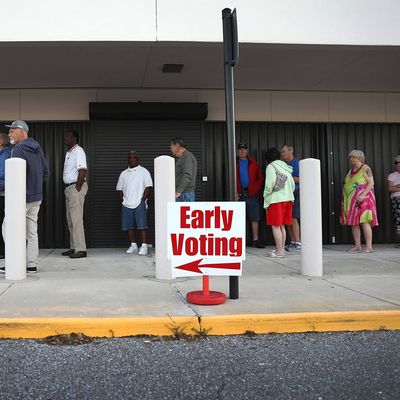
Somewhere between 30 and 40 percent of voters in the 2016 general election will cast ballots before November 8, some by mail, some in person. Because “Election Day” is already under way in much of the country via early voting, reports (or partisan boasts) on early-voting trends get a lot of attention.
But in this area more than almost any other, America’s radically decentralized system of elections makes generalizations perilous. The one thing we can infallibly say is that no votes have yet been counted. When it is reported that one party or the other is “winning” early-voting battles, what that typically means is that said party is doing better than it did in the last presidential election according to the number of absentee ballots requested or returned, or ballots cast in person, by people registered to that party. So you see one limitation right away: There is no way to know for sure what percentage of registered Democrats or Republicans — much less the non-affiliated — are voting for Democratic or Republican candidates. And then there are the 19 states — including the battleground states of Ohio and Wisconsin — who do not have voter registration by party.
While the national trend is toward heavier reliance on early voting, state laws and practices vary enormously. Three states (Colorado, Oregon, and Washington) now conduct voting entirely by mail. But 13 others (especially in the northeast) limit early voting to those who have a stated excuse for not being able to vote on Election Day. And so, in the last presidential election, in the battleground states the percentage of the vote cast early ranged from 81 percent in Colorado and 62 percent in North Carolina all the way down to 10 percent in New Hampshire and 5 percent in Pennsylvania.
Early-voting advantages tend to reflect a party strategy of “banking” reliable votes early so as to concentrate Election Day resources on persuadable or marginal voters, and/or a big advantage in get-out-the-vote infrastructure, such as the one generally conceded to Hillary Clinton’s campaign this year. Any way you slice it, such an advantage is a good thing, but not a reliable indicator of ultimate victory except in those states where most votes are cast early.
So having said all this, what do we know so far about early voting in key battleground states?
Overall, early voting appears to be up significantly as compared to 2012, and that is with 34 of the 37 states with real early-voting opportunities having already received votes. As always, Republicans are leading in absentee ballots returned in Florida and North Carolina, but not by the margins they had in 2012. Thus, as in-person early voting gets under way in both states, Democrats look to be in good shape. Early-voting guru Michael McDonald had this report from North Carolina over the weekend:
On Wednesday, registered Republicans held a lead of 2,641 returned ballots over registered Democrats, or a lead of 4.7 percentage point lead among all returned ballots. Then in-person early voting started, and 385,410 voters cast ballots in-person by the end of Saturday. The number of registered Democrats voting increased dramatically, and they jumped into a lead of 80,303 returned ballots over Republicans by the end of Saturday, or a 13.9 percentage point lead among all returned ballots.
In-person voting began in Florida today, and McDonald suspects the overall numbers will follow a trajectory similar to that of North Carolina. In Nevada, a mammoth get-out-the-vote organization created by outgoing Senate Democratic leader Harry Reid is showing signs of its usual dominance as in-person early voting got under way in that state this weekend. All three of these states not only have close presidential contests, but crucial Senate races as well.
Things do not look so rosy for Democrats in two other battleground states with heavy early voting: Iowa (44 percent of the vote cast early in 2012) and Ohio (33 percent in 2012). Iowa Democrats have always prided themselves on an outstanding early-voting operation, but they are running well behind their 2012 numbers. And in Ohio, which does not have party registration, the main danger sign for Democrats is lagging early voting in the big urban centers of Cleveland and Columbus.
Ohio and Iowa have been Trump’s two best battleground states. So while it is encouraging for his cause that he’s doing relatively well in early voting in those two states, it’s more significant that he’s doing not-so-well in Florida and North Carolina, both of which he badly needs to get to 270 electoral votes.
One other straw in the wind worth noting comes from the very blue state of California, where one analysis shows Latino early voting up 45 percent as compared to 2016. If that is accurate, it could reflect surprisingly high Latino turnout not only in California but elsewhere, and show a Trump effect of energizing the Democratic base.
So what should the discerning political junkie look for in early voting down the stretch? One key thing to remember is that national numbers on early voting are largely meaningless (at least in the presidential race) because they are skewed heavily by giant California (where about 70 percent of the vote is cast early). Another is that absolute numbers can be misleading, and comparisons to the close and recent 2012 election are best. As in-person early voting hits its stride in Florida, North Carolina, and Ohio (and also in non-battleground but increasingly competitive Georgia), Democrats should have positive data to boast of in all three states. And if Democrats are taking full advantage of their infrastructure investments, the percentage of the vote cast early should be up significantly. Indeed, in their better states with heavy early voting, you can expect Democrats to boast the election is over before long. Those are words most Americans long to hear.






























